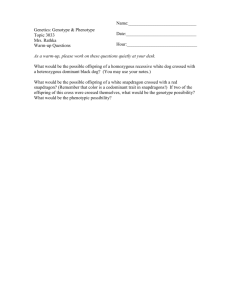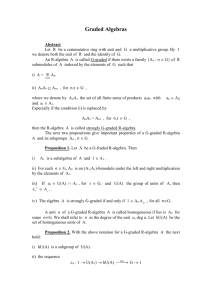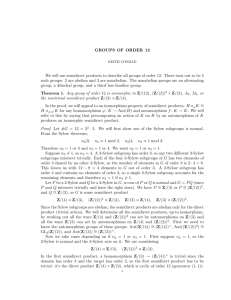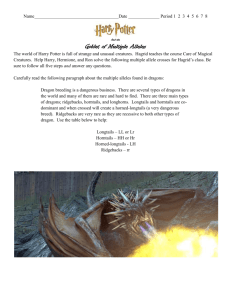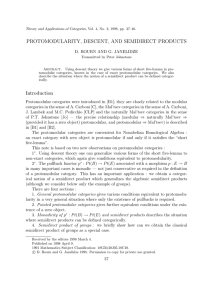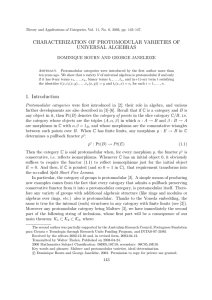SEMIDIRECT PRODUCTS AND CROSSED MODULES IN VARIETIES OF RIGHT Ω-LOOPS
advertisement
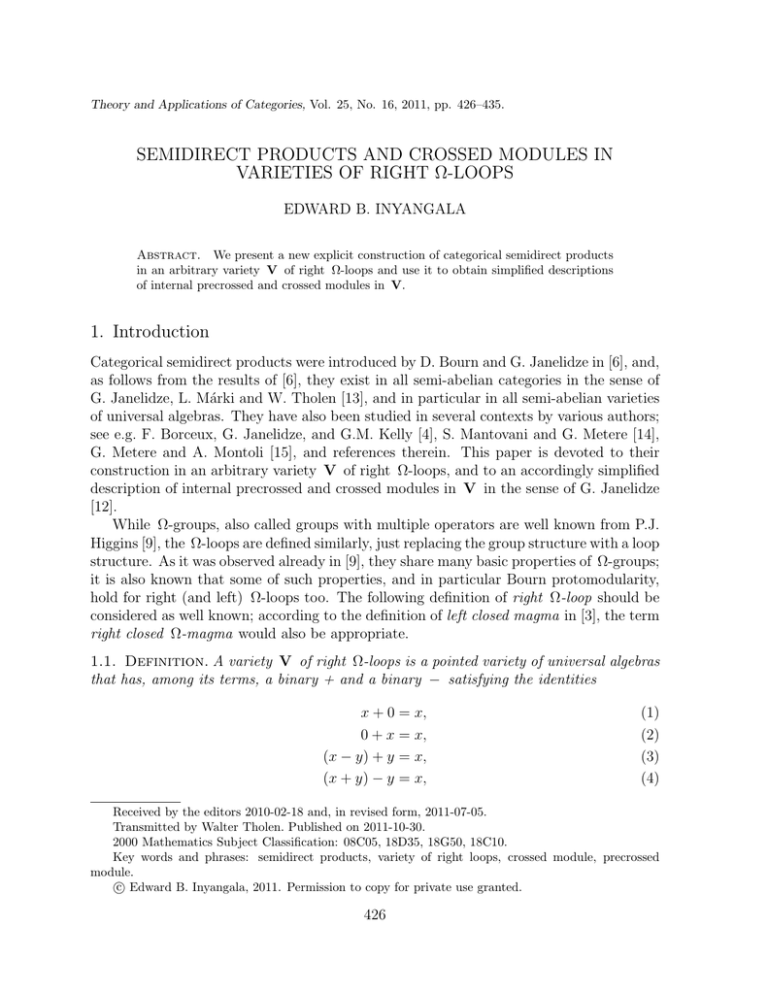
Theory and Applications of Categories, Vol. 25, No. 16, 2011, pp. 426–435.
SEMIDIRECT PRODUCTS AND CROSSED MODULES IN
VARIETIES OF RIGHT Ω-LOOPS
EDWARD B. INYANGALA
Abstract. We present a new explicit construction of categorical semidirect products
in an arbitrary variety V of right Ω-loops and use it to obtain simplified descriptions
of internal precrossed and crossed modules in V.
1. Introduction
Categorical semidirect products were introduced by D. Bourn and G. Janelidze in [6], and,
as follows from the results of [6], they exist in all semi-abelian categories in the sense of
G. Janelidze, L. Márki and W. Tholen [13], and in particular in all semi-abelian varieties
of universal algebras. They have also been studied in several contexts by various authors;
see e.g. F. Borceux, G. Janelidze, and G.M. Kelly [4], S. Mantovani and G. Metere [14],
G. Metere and A. Montoli [15], and references therein. This paper is devoted to their
construction in an arbitrary variety V of right Ω-loops, and to an accordingly simplified
description of internal precrossed and crossed modules in V in the sense of G. Janelidze
[12].
While Ω-groups, also called groups with multiple operators are well known from P.J.
Higgins [9], the Ω-loops are defined similarly, just replacing the group structure with a loop
structure. As it was observed already in [9], they share many basic properties of Ω-groups;
it is also known that some of such properties, and in particular Bourn protomodularity,
hold for right (and left) Ω-loops too. The following definition of right Ω-loop should be
considered as well known; according to the definition of left closed magma in [3], the term
right closed Ω-magma would also be appropriate.
1.1. Definition. A variety V of right Ω-loops is a pointed variety of universal algebras
that has, among its terms, a binary + and a binary − satisfying the identities
x + 0 = x,
0 + x = x,
(x − y) + y = x,
(x + y) − y = x,
(1)
(2)
(3)
(4)
Received by the editors 2010-02-18 and, in revised form, 2011-07-05.
Transmitted by Walter Tholen. Published on 2011-10-30.
2000 Mathematics Subject Classification: 08C05, 18D35, 18G50, 18C10.
Key words and phrases: semidirect products, variety of right loops, crossed module, precrossed
module.
c Edward B. Inyangala, 2011. Permission to copy for private use granted.
426
SEMIDIRECT PRODUCTS AND CROSSED MODULES IN VARIETIES
427
where 0 is the unique constant of V.
1.2. Remark. The identities above easily imply that x − x = 0.
Indeed, x − x = (0 + x) − x = 0.
Briefly, our descriptions of semidirect products and (pre)crossed modules are obtained
using the fact that the right Ω-loops are, in some sense, exactly the algebraic structures
whose semidirect products have the corresponding cartesian products as their underlying
sets.
2. Preliminaries
A pointed finitely cocomplete category C is said to be semi-abelian (in the sense of [13])
if it is exact in the sense of M. Barr [1] and protomodular in the sense of D. Bourn [5] (see
also F. Borceux [2] and F. Borceux and D. Bourn [3]). Since every variety of universal
algebras is (small-)cocomplete and exact, it is semi-abelian if and only if it is pointed and
protomodular. As shown by D. Bourn and G. Janelidze [7], a variety of universal algebras
is protomodular if and only if it admits nullary terms e1 , ..., en , binary terms t1 , ..., tn ,
and (n + 1)-ary term t, satisfying the identities
t(t1 (x, y), ..., tn (x, y), y) = x and ti (x, x) = ei (i = 1, ..., n).
In particular every variety of right Ω-loops is protomodular, and therefore semi-abelian:
just take n = 1, e1 = 0, t1 (x, y) = x − y, and t(x, y) = x + y. Moreover, the pointed case
is well known in universal algebra from the work of A. Ursini and his collaborators (see
[8], [18], [19]).
For an object B in a semi-abelian category C consider the diagram
P tD C (B)
:
\: ::
::: ::
:: ::
F :: ::K
: :
U
L :: ::
:: ::
:: :
T
U
o
/ CT
C
(5)
FT
in which:
• P tC (B) is the category of points over B as used in various above-mentioned papers
(originally [5]). That is, the objects in P tC (B) are triples (A, α, β), where α :
A −→ B and β : B −→ A are morphisms in C in with αβ = 1B . A morphism
f : (A, α, β) −→ (A0 , α0 , β 0 ) in P tC (B) is a morphism f : A −→ A0 in C with
α0 f = α and f β = β 0 .
• U is a functor defined by U (A, α, β) = Ker(α), and F is its left adjoint, defined
therefore by F (X) = (B + X, [1, 0], ι1 ), in the obvious notation.
428
EDWARD B. INYANGALA
• T is the monad on C determined by the adjoint pair (F, U ), CT the category
of T B -algebras, and U T , F T , and K are the corresponding forgetful functor, free
functor, and comparison functor respectively. L is the left adjoint of K. Recall that,
for X in C, we have T (X) = B[X = ker([1, 0] : B + X −→ B).
As shown in [6], the functor U is monadic; and, according to [6], for a T B -algebra (X, ξ)
(or a B-action (X, ξ) in the sense of [4]), the semidirect product (B n (X, ξ), πξ , ιξ ) is
defined as the object in P tC (B) corresponding to (X, ξ) under the equivalence (K, L).
Equivalently,
(B n (X, ξ), πξ , ιξ ) = L(X, ξ).
(6)
As usually, by the semidirect product of B and (X, ξ) we will sometimes mean (just) the
object B n (X, ξ). When C is a pointed protomodular variety of universal algebras, we
have
B[X = {t(b1 , ..., bp , x1 , ..., xq ) ∈ B + X| t(b1 , ..., bp , 0, ..., 0) = 0},
(7)
and B n (X, ξ) can be presented as B n (X, ξ) = (B + X)/E, where E is the congruence
on the coproduct B + X generated by {(t, ξ(t))|t ∈ B[X}, considering both B[X and
X as subalgebras of B + X.
Let us also recall the explicit description of the comparison functor K. For (A, α, β)
in P tC (B), consider the diagram
ι1
B[X
κB,X
/
B+X
B
(8)
[β,κ]
ξ
X
/
[1,0]
κ
/
A]
α
/
B
β
where (B[X, κB,X ) is the kernel of [1, 0], (X, κ) is the kernel of α, and ξ is the induced
morphism between these kernels. We can write K(A, α, β) = (X, ξ).
3. Simplified description of semidirect products
The main result of this paper is the following:
3.1. Theorem. Let V variety of right Ω-loops. Given an object B and a T B -algebra
(X, ξ), the semidirect product B n (X, ξ) is the set-theoretical product B × X equipped
with the Ω-algebra structure defined by:
ω((b1 , x1 ), ..., (bn , xn )) = (ω(b1 , ..., bn ), ξ(ω(x1 + b1 , ..., xn + bn ) − ω(b1 , ..., bn ))),
(9)
SEMIDIRECT PRODUCTS AND CROSSED MODULES IN VARIETIES
429
for each n-ary operation ω ∈ Ω and f or all b1 , ..., bn ∈ B, x1 , ..., xn ∈ X. The corresponding πξ : B × X −→ B and ιξ : B −→ B × X are given by πξ (b, x) = b and
ιξ (b) = (b, 0) respectively.
Proof. Consider the diagram in the category of sets
β
/
κ
X
ϕ
X
h0,1i
/
α
A
J
/
B
(10)
ψ
B × ^X
π1
/
B
h1,0i
where αβ = 1B , κ = ker(α) and the maps ϕ and ψ are defined as follows:
ϕ : B × X −→ A,
ψ : A −→ B × X,
(b, x) 7−→ κ(x) + β(b)
a 7−→ α(a), κ−1 (a − βα(a)) .
We then have
ψϕ(b, x) = ψ(κ(x) + β(b)) = (b, κ−1 ((κ(x) + β(b)) − β(b)) = (b, x)
ϕψ(a) = ϕ(α(a), κ−1 (a − βα(a))) = (a − βα(a)) + βα(a) = a.
Therefore ϕ and ψ are bijections, inverse to each other. Together with (6) and (8) this
allows us to construct the semidirect product B n (X, ξ) as the cartesian product B × X
(in the category of sets) equipped with the unique algebraic structure making ϕ and ψ
isomorphisms. For this, structure we have
ω((b1 , x1 ), ...(bn , xn )) = ψ(ω(ϕ(b1 , x1 ), ..., ϕ(bn , xn ))) (using ψϕ = 1B×X )
= ψ(ω(κ(x1 ) + β(b1 ), ..., κ(xn ) + β(bn ))) = (α(ω(κ(x1 ) + β(b1 ), ..., κ(xn ) + β(bn ))),
κ−1 [ω(κ(x1 ) + β(b1 ), ..., κ(xn ) + β(bn )) − βαω(κ(x1 ) + β(b1 ), ..., κ(xn ) + β(bn ))])
= (ω(b1 , ..., bn ), κ−1 [ω(κ(x1 ) + β(b1 ), ..., κ(xn ) + β(bn )) − ω(β(b1 ), ..., β(bn ))])
= (ω(b1 , ..., bn ), κ−1 [β, κ](ω(x1 + b1 , ..., xn + bn ) − ω(b1 , ..., bn )))
= (ω(b1 , ..., bn ), ξ(ω(x1 + b1 , ..., xn + bn ) − ω(b1 , ..., bn ))) (11)
where the last equality follows from the commutativity of the left-hand square in diagram
(8). Next, we have αϕ = π1 , ϕh1, 0i = β and ϕh0, 1i = κ in (10). Indeed
αϕ(b, x) = ακ(x) + αβ(x) = 0 + x,
ϕh0, 1i(x) = ϕ(0, x) = κ(x) + 0 = κ(x),
ϕh1, 0i(b) = ϕ(b, 0) = 0 + β(b) = β(b).
430
EDWARD B. INYANGALA
This allows us to identify πξ with π1 : B × X −→ B and ιξ with h1, 0i : B −→ B × X.
Therefore
πξ (b, x) = π1 (b, x) = b, ιξ (b) = h1, 0i(b) = (b, 0).
The identities (1), (2), (3) and (4) of Definition 1.1 are actually not only sufficient but
also necessary for our definition of ϕ and ψ to determine bijections inverse to each other
and to make the relevant parts of diagram (10) commutative. To show this consider the
following three instances of diagram (10):
β=0
X
κ=1X
/
X
J
ϕ
X
h0,1i
/
α=0
/
0
π1
/
0
(12)
ψ
0×X
]
h0,0i
β=1X
0
/
κ=0
X
J
ϕ
0
X ×] 0
h0,0i
/X
π1
/X
(13)
ψ
/
α=1X
h1,0i
β=h1,1i
X
κ=h0,1i
/
X×
J X
ϕ
X
h0,1i
/
α=π1
/
X
(14)
ψ
X × ^X
π1
/
X
h1,0i
In (12), we have ϕh0, 1i(x) = ϕ(0, x) = x + 0, κ(x) = x, and since the left-hand square
commutes, we have x + 0 = x.
In (13), we have αϕ(x, 0) = 0 + x, π1 (x, 0) = 0 and since αϕ = π1 , we obtain
0 + x = x.
SEMIDIRECT PRODUCTS AND CROSSED MODULES IN VARIETIES
431
In (14), we have
ϕψ(y, x) = ϕ(y, κ−1 ((y, x) − (y, y)))
= ((y, x) − (y, y)) + (y, y)
= ((y − y) + y, (x − y) + y),
ψϕ(y, x) = ψ((0, x) + (y, y))
= ψ(0 + y, x + y) = ψ(y, x + y)
= (y, κ−1 ((y, x + y) − (y, y)))
= (y, κ−1 (y − y, (x + y) − y))
and since ϕ and ψ must be inverse to each other, we obtain (x − y) + y = x and
(x + y) − y = x.
3.2. Remarks. (a) As follows from (9), we have
(b1 , x1 ) + (b2 , x2 ) = (b1 + b2 , ξ(((x1 + b1 ) + (x2 + b2 )) − (b1 + b2 ))).
(b) For any variety of right Ω-loops, we have
(0, x)+(b, 0) = (0+b, ξ(((x+0)+(0+b))−(0+b))) = (b, ξ((x+b)−b)) = (b, ξ(x)) = (b, x),
and in particular for Ω-groups this gives (b1 , x1 ) + (b2 , x2 ) = (b1 + b2 , x1 + ξ(b1 + x2 − b1 )).
for all b1 , b2 ∈ B and x1 , x2 ∈ X.
4. Crossed modules in a variety of right Ω-loops
In this section we apply the construction of the semidirect product to describe precrossed
and crossed modules in varieties of right Ω-loops. Let us recall the following definitions,
in which ι2 : X −→ B + X and κB,X : B[X −→ B + X denote the second coproduct
injection and the kernel of [1, 0] : B + X −→ B respectively.
4.1. Definition. [12] An internal precrossed module in a semi-abelian category C is a
4-tuple (B, X, ξ, δ) in which (X, ξ) is a B-action and δ : X −→ B a morphism in C
such that the diagram
B[X
κB,X
/
B+X
ξ
[1,δ]
X
commutes.
δ
/
B
(15)
432
EDWARD B. INYANGALA
4.2. Definition. [12] An internal crossed module in a semi-abelian category C is an
internal precrossed module (B, X, ξ, δ) for which the diagram
(B + X)[X
[1B ,δ][1X
/
B[X
[1B+X ,ι2 ]]
(16)
ξ
B[X
ξ
/
X
commutes. Here, [1B+X , ι2 ]] is the unique morphism such that κB,X [1B+X , ι2 ]] = [1B+X , ι2 ]κB+X,X .
4.3. Theorem. A precrossed module in a variety V of right Ω-loops can equivalently be
defined as a quadruple (B, X, ξ, δ) in which (X, ξ) is a B-action and δ : X −→ B is a
morphism such that for an n-ary operation ω ∈ Ω,
ω(δ(x1 ) + b1 , ..., δ(xn ) + bn ) − ω(b1 , ..., bn )
= δ(ξ(ω(x1 + b1 , ..., xn + bn ) − ω(b1 , ..., bn ))) (17)
for all x1 , ..., xn ∈ X, b1 , ..., bn ∈ B.
Proof. As explained in [12], a precrossed module in V corresponds to a reflexive graph
α
BnX o
β
?B
(18)
γ
with α(b, x) = b and β(b) = (b, 0).
Since γ is a homomorphism and (b, x) = (0, x) + (b, 0) , we have
γ(b, x) = γ(0, x) + γ(b, 0) = γ(0, x) + b. This shows that γ is completely determined by
γ(0, x), f or all x ∈ X. We introduce the morphism δ : X −→ B defined by δ(x) =
γ(0, x) and then γ(b, x) = δ(x) + b for each b ∈ B and each x ∈ X. This means that
a precrossed module in V can be defined as quadruple (B, X, ξ, δ), in which (X, ξ) is
a B -action and δ : X −→ B a morphism in V such that γ : B n X −→ B defined by
γ(b, x) = δ(x) + b is also a morphism in V.
For an n-ary operation ω ∈ Ω,
ω(γ(b1 , x1 ), ..., γ(bn , xn )) = ω(δ(x1 ) + b1 , ..., δ(xn ) + bn ),
(19)
γ(ω((b1 , x1 ), ..., (bn , xn ))) = γ(ω(b1 , ..., bn ), ξ(ω(x1 + b1 , ..., xn + bn ) − ω(b1 , ...bn )))
= δ(ξ(ω(x1 + b1 , ..., xn + bn ) − ω(b1 , ..., bn ))) + ω(b1 , ..., bn ) (20)
for x1 , ..., xn ∈ X and b1 , ..., bn ∈ B. Therefore, γ is a morphism if and only if (17)
holds.
SEMIDIRECT PRODUCTS AND CROSSED MODULES IN VARIETIES
433
4.4. Theorem. A crossed module in a variety V of Ω-loops can be defined as a precrossed
module (B, X, ξ, δ) with
ξ(ω(x01 + (δ(x1 ) + b1 ), ..., x0n + (δ(xn ) + bn )) − ω(δ(x1 ) + b1 , ..., δ(xn ) + bn ))+
ξ(ω(x1 + b1 , ..., xn + bn ) − ω(b1 , ..., bn ))
= ξ(ω((x01 + x1 ) + b1 , ..., (x0n + xn ) + bn ) − ω(b1 , ..., bn )) (21)
for all b01 , ..., b0n ∈ B, x1 , ..., xn ∈ X and x01 , ...x0n ∈ X.
Proof. As follows from the results of [11] and [12], a precrossed module module (B, X, ξ, δ)
is a crossed module if and only if the map
m : (B n X) ×B (B n X)
/
BnX
defined by m(u, v) = p(u, βα(u), v) is a morphism in V; here p is any Mal’tsev term in
V and α and β are as in (18). In our case, using Theorem 3.1, we can simplify the
definition of m as follows:
m((b0 , x0 ), (b, x)) = p((b0 , x0 ), (b0 , 0), (b, x)) = ((b0 , x0 ) − (b0 , 0)) + (b, x) = (b, x0 + x).
We then calculate, for any n-ary ω
m(ω((b01 , x01 ), ..., (b0n , x0n )), ω((b1 , x1 ), ..., (bn , xn )))
= m((ω(b01 , ..., b0n ), ξ(ω(x01 + b01 , ..., x0n + b0n ) − ω(b01 , ..., b0n ))),
(ω(b1 , ..., bn ), ξ(ω(x1 + b1 , ...xn + bn ) − ω(b1 , ..., bn ))))
= (ω(b1 , ..., bn ), ξ(ω(x01 + b01 , ..., x0n + b0n ) − ω(b01 , ..., b0n ))+
ξ(ω(x1 + b1 , ..., xn + bn ) − ω(b1 , ..., bn ))) (22)
and
ω(m((b01 , x01 )(b1 , x1 )), ..., m((b0n , x0n )(bn , xn )))
= ω((b1 , x01 + x1 ), ..., (bn , x0n + xn )) = (ω(b1 , ..., bn ),
ξ(ω((x01 + x1 ) + b1 , ..., (x0n + x1 ) + bn ) − ω(b1 , ..., bn ))) (23)
for b1 , ..., bn ∈ B, b01 , ..., b0n ∈ B, x1 , ..., xn ∈ X,
b0i = δ(xi ) + bi , i = 1, ..., n. Using the fact that
x01 , ..., x0n ∈ X with
((b0 , x0 ), (b, x)) ∈ (B n X) ×B (B n X)
if and only if b0 = δ(x) + b, we conclude that m is a morphism in V if and only if (21) is
satisfied.
434
EDWARD B. INYANGALA
4.5. Remarks and examples. When ω is the same as +, and it is associative, the
formula bx = ξ(b + x − b) defined by a B-action on X (see [6]), and the equalities (17) and
(21) become δ(b1 x2 ) = b1 +δ(x2 )−b1 and δ(x1 )(b1 x02 ) = x1 +b1 x02 −x1 respectively. They
are obviously equivalent to the classical δ(bx) = b + δ(x) − b and δ(x)(x0 ) = x + x0 − x,
which define crossed modules, originally by J.H.C. Whitehead [17]. More generally, (17)
and (21) conveniently apply to the context of G. Orzech [16], and still, more generally,
to the context of distributive Ω2 -loops in the sense of S. Mantovani and G. Metere [14].
On the other hand (17) and (21) are special cases of conditions imposed in [12]; they are
expressed in [12] as commutativity of diagrams (2.1) and (3.14) respectively. However,
we did not obtain (17) and (21) directly from those diagrams, and:
(a) We do not know how to deduce the commutativity of diagrams (2.1) and (3.14) in
[12] directly from (17) and (21), that is, not using the reflexive graph (18) and the
map m : (B n X) ×B (B n X) −→ B n X (which in fact means: we do not know
how to do it using Theorem 3.1).
(b) Applying (17) and (21) to groups, and to contexts of [14] and [16] (which include
not only groups but many classical algebraic structures, e.g. associative and Lie,
and general non-associative algebras over rings), gives the known descriptions of
(pre)crossed modules much more easily than the results of [12].
Acknowledgements
The results of this paper formed part of the author’s PhD thesis [10] at the University
of Cape Town. I would like to thank my supervisor Prof. George Janelidze for his encouragement and support. I would also like to thank the referee whose comments and
suggestions helped improve the final version of the paper.
References
[1] M. Barr, Exact categories, Lecture Notes in Mathematics, vol. 236, Springer, 1971,
1-120.
[2] F. Borceux, A survey of semi-abelian categories, Fields Institute Communications
43, 2004, 27-60.
[3] F. Borceux and D. Bourn, Mal’cev, protomodular, homological and semi-abelian categories, Mathematics and its Applications, vol. 566, Kluwer Academic Publishers,
2004.
[4] F. Borceux, G. Janelidze and G. M. Kelly, Internal object actions, Comment. Math.
Univ. Carolinae 46 (2005), no. 2, 235-255.
SEMIDIRECT PRODUCTS AND CROSSED MODULES IN VARIETIES
435
[5] D. Bourn, Normalization equivalence, kernel equivalence, and affine categories, Lecture Notes in mathematics, vol. 1488, Springer, (1991), 43-62.
[6] D. Bourn and G. Janelidze, Protomodularity, descent and semidirect products, Theory
Appl. Categ. 4 (1998), no. 2, 37-46.
[7] D. Bourn and G. Janelidze, Characterization of protomodular varieties of universal
algebras, Theory Appl. Categ. 11 (2003), no. 6, 143-147.
[8] H. P. Gumm and A. Ursini, Ideals in universal algebras, Algebra Universalis 19, 1984,
45-54.
[9] P. J. Higgins, Groups with multiple operators, Proc. London. Math. Soc. (3) 6 (1956),
366-416.
[10] E. B. Inyangala, Categorical semidirect products in varieties of groups with multiple
operators, PhD thesis, University of Cape Town, 2010.
[11] G. Janelidze, Internal categories in Malcev varieties, preprint, York University,
Toronto, 1990.
[12] G. Janelidze, Internal crossed modules, Georgian Math. J. 10 (2003), no. 1, 99-114.
[13] G. Janelidze, L. Márki and W. Tholen, Semi-abelian categories, J. Pure Appl. Algebra
168 (2002), 367-386.
[14] S. Mantovani and G. Metere, Internal crossed modules and Peiffer condition, Theory
Appl. Categ. 23 (2010), no. 6, 113-135.
[15] G. Metere and A. Montoli, Semidirect products of internal groupoids, J. Pure Appl.
Algebra (2010), 10 (2010), 1854-1861.
[16] G. Orzech, Obstruction theory in algebraic categories I and II, J. Pure. Appl. Algebra
2 (1972), 287-314 and 315-340.
[17] J. H. C Whitehead, Combinatorial homotopy II, Bull. Amer. Math. Soc. 55 (1949),
453-496.
[18] A. Ursini, Osservazioni sulla varietá BIT, Bolletino della Unione Matematica Italiana
8, 1973, 205-211.
[19] A. Ursini, On subtractive varieties I, Algebra Universalis 31, 1994, 204-222.
Department of Mathematics and Applied Mathematics, University of Limpopo
Private Bag X1106, Sovenga 0727, South Africa
Email: E.Inyangala@gmail.com
This article may be accessed at http://www.tac.mta.ca/tac/ or by anonymous ftp at
ftp://ftp.tac.mta.ca/pub/tac/html/volumes/25/16/25-16.{dvi,ps,pdf}
THEORY AND APPLICATIONS OF CATEGORIES (ISSN 1201-561X) will disseminate articles that
significantly advance the study of categorical algebra or methods, or that make significant new contributions to mathematical science using categorical methods. The scope of the journal includes: all areas of
pure category theory, including higher dimensional categories; applications of category theory to algebra,
geometry and topology and other areas of mathematics; applications of category theory to computer
science, physics and other mathematical sciences; contributions to scientific knowledge that make use of
categorical methods.
Articles appearing in the journal have been carefully and critically refereed under the responsibility of
members of the Editorial Board. Only papers judged to be both significant and excellent are accepted
for publication.
Full text of the journal is freely available in .dvi, Postscript and PDF from the journal’s server at
http://www.tac.mta.ca/tac/ and by ftp. It is archived electronically and in printed paper format.
Subscription information Individual subscribers receive abstracts of articles by e-mail as they
are published. To subscribe, send e-mail to tac@mta.ca including a full name and postal address. For institutional subscription, send enquiries to the Managing Editor, Robert Rosebrugh, rrosebrugh@mta.ca.
The typesetting language of the journal is TEX, and LATEX2e
strongly encouraged. Articles should be submitted by e-mail directly to a Transmitting Editor. Please
obtain detailed information on submission format and style files at http://www.tac.mta.ca/tac/.
Information for authors
Managing editor Robert Rosebrugh, Mount Allison University: rrosebrugh@mta.ca
TEXnical editor Michael Barr, McGill University: barr@math.mcgill.ca
Assistant TEX editor Gavin Seal, Ecole Polytechnique Fédérale de Lausanne:
gavin seal@fastmail.fm
Transmitting editors
Clemens Berger, Université de Nice-Sophia Antipolis, cberger@math.unice.fr
Richard Blute, Université d’ Ottawa: rblute@uottawa.ca
Lawrence Breen, Université de Paris 13: breen@math.univ-paris13.fr
Ronald Brown, University of North Wales: ronnie.profbrown(at)btinternet.com
Aurelio Carboni, Università dell Insubria: aurelio.carboni@uninsubria.it
Valeria de Paiva: valeria.depaiva@gmail.com
Ezra Getzler, Northwestern University: getzler(at)northwestern(dot)edu
Martin Hyland, University of Cambridge: M.Hyland@dpmms.cam.ac.uk
P. T. Johnstone, University of Cambridge: ptj@dpmms.cam.ac.uk
Anders Kock, University of Aarhus: kock@imf.au.dk
Stephen Lack, Macquarie University: steve.lack@mq.edu.au
F. William Lawvere, State University of New York at Buffalo: wlawvere@buffalo.edu
Tom Leinster, University of Glasgow, Tom.Leinster@glasgow.ac.uk
Jean-Louis Loday, Université de Strasbourg: loday@math.u-strasbg.fr
Ieke Moerdijk, University of Utrecht: moerdijk@math.uu.nl
Susan Niefield, Union College: niefiels@union.edu
Robert Paré, Dalhousie University: pare@mathstat.dal.ca
Jiri Rosicky, Masaryk University: rosicky@math.muni.cz
Brooke Shipley, University of Illinois at Chicago: bshipley@math.uic.edu
James Stasheff, University of North Carolina: jds@math.upenn.edu
Ross Street, Macquarie University: street@math.mq.edu.au
Walter Tholen, York University: tholen@mathstat.yorku.ca
Myles Tierney, Rutgers University: tierney@math.rutgers.edu
Robert F. C. Walters, University of Insubria: robert.walters@uninsubria.it
R. J. Wood, Dalhousie University: rjwood@mathstat.dal.ca
